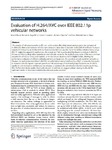Mostrar o rexistro simple do ítem
Evaluation of H.264/AVC over IEEE 802.11p vehicular networks
| dc.contributor.author | Rozas-Ramallal, Ismael | |
| dc.contributor.author | Fernández-Caramés, Tiago M. | |
| dc.contributor.author | Dapena, Adriana | |
| dc.contributor.author | García-Naya, José A. | |
| dc.date.accessioned | 2024-03-26T10:19:44Z | |
| dc.date.available | 2024-03-26T10:19:44Z | |
| dc.date.issued | 2013 | |
| dc.identifier.citation | Rozas-Ramallal, I., Fernández-Caramés, T.M., Dapena, A. et al. Evaluation of H.264/AVC over IEEE 802.11p vehicular networks. EURASIP J. Adv. Signal Process. 2013, 77 (2013). https://doi.org/10.1186/1687-6180-2013-77 | es_ES |
| dc.identifier.issn | 1687-6180 | |
| dc.identifier.issn | 1687-6172 | |
| dc.identifier.uri | http://hdl.handle.net/2183/35993 | |
| dc.description.abstract | [Abstract]: The capacity of vehicular networks to offer non-safety services, like infotainment applications or the exchange of multimedia information between vehicles, have attracted a great deal of attention to the field of Intelligent Transport Systems (ITS). In particular, in this article we focus our attention on IEEE 802.11p which defines enhancements to IEEE 802.11 required to support ITS applications. We present an FPGA-based testbed developed to evaluate H.264/AVC (Advanced Video Coding) video transmission over vehicular networks. The testbed covers some of the most common situations in vehicle-to-vehicle and roadside-to-vehicle communications and it is highly flexible, allowing the performance evaluation of different vehicular standard configurations. We also show several experimental results to illustrate the quality obtained when H.264/AVC encoded video is transmitted over IEEE 802.11p networks. The quality is measured considering two important parameters: the percentage of recovered group of pictures and the frame quality. In order to improve performance, we propose to substitute the convolutional channel encoder used in IEEE 802.11p for a low-density parity-check code encoder. In addition, we suggest a simple strategy to decide the optimum number of iterations needed to decode each packet received. | es_ES |
| dc.description.sponsorship | This study was funded by Xunta de Galicia, Ministerio de Ciencia e Innovacion´ of Spain, and FEDER funds of the European Union under grants with numbers 10TIC105003PR, TEC2010-19545-C04-01, and CSD2008-00010. | es_ES |
| dc.description.sponsorship | Xunta de Galicia; 10TIC105003PR | es_ES |
| dc.language.iso | eng | es_ES |
| dc.publisher | SpringerOpen & European Association for Signal Processing | es_ES |
| dc.relation | info:eu-repo/grantAgreement/MICINN/Plan Nacional de I+D+i 2008-2011/TEC2010-19545-C04-01/ES/ESTRATEGIAS COOPERATIVAS Y COGNITIVAS PARA LA GESTION DE INTERFERENCIAS EN REDES DE COMUNICACIONES INALAMBRICAS/ | es_ES |
| dc.relation | info:eu-repo/grantAgreement/MICINN/Plan Nacional de I+D+i 2008-2011/CSD2008-00010/ES/FOUNDATIONS AND METHODOLOGIES FOR FUTURE COMMUNICATION AND SENSOR NETWORKS/ | es_ES |
| dc.relation.uri | https://doi.org/10.1186/1687-6180-2013-77 | es_ES |
| dc.rights | Atribución 3.0 España | es_ES |
| dc.rights.uri | http://creativecommons.org/licenses/by/3.0/es/ | * |
| dc.subject | LDPC Code | es_ES |
| dc.subject | Convolutional Code | es_ES |
| dc.subject | Video Transmission | es_ES |
| dc.subject | Vehicular Network | es_ES |
| dc.subject | OFDM Symbol | es_ES |
| dc.title | Evaluation of H.264/AVC over IEEE 802.11p vehicular networks | es_ES |
| dc.type | info:eu-repo/semantics/article | es_ES |
| dc.rights.access | info:eu-repo/semantics/openAccess | es_ES |
| UDC.journalTitle | EURASIP Journal on Advances in Signal Processing | es_ES |
| UDC.volume | 2013 | es_ES |
| UDC.issue | 77 | es_ES |
| UDC.startPage | 1 | es_ES |
| UDC.endPage | 13 | es_ES |
| dc.identifier.doi | 10.1186/1687-6180-2013-77 |
Ficheiros no ítem
Este ítem aparece na(s) seguinte(s) colección(s)
-
GI-GTEC - Artigos [190]






